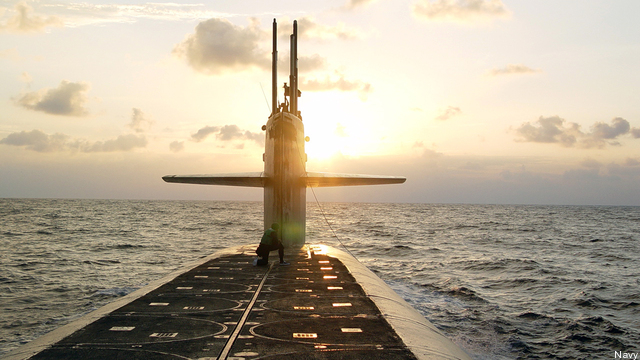The House Appropriations defense subcommittee pressed the leaders of the Navy and Marine Corps today about how they could meet the national security challenges with shrinking budgets, questioning the survivability of the Littoral Combat Ships, the status of the costly and controversial Joint Strike Fighter and the Navy’s plan to take seven cruisers and possibly an aircraft carrier out of service.
Led by its chairman, Rep. Rodney Frelinghuysen of New Jersey, the panel members also raised serious concerns about the rash of scandals and leadership failures that recently have troubled the Navy.
Frelinghuysen, in his first year running the panel, contrasted the shrinking U.S. fleet with the rapidly growing Chinese force, “which already is challenging our Navy power and our allies every single day.”
The chairman also cited the high number of Navy commanders being relieved for misconduct, the allegations of cheating by students at the Navy’s nuclear power school, the acceptance of bribes and even prostitutes by senior Navy officers in exchange for helping a Singapore-based ship service contactor get business.
“We need an explanation of what’s going on,” he told Navy Secretary Ray Mabus, Adm. Jonathan Greenert, chief of naval operations, and Gen. James Amos, Marine Corps Commandant. Frelinghuysen’s concerns were shared by other committee members.
Although much of the panel’s questioning about the proposed 2015 defense budget dealt with the broad issues of a shrinking military in an unstable and threatening world, many of members focused, as is usual, on issues that affect their districts.
Florida Rep. Ander Crenshaw, worried about Mayport Naval Station, attacked the Navy’s recent change in how it counts its battle fleet (which added 10 ships), asking how the Navy was going to maintain its forward presence “with ghost ships.”
Mabus insisted the added ships, including two hospital vessels and six small coastal patrol craft, were added because the combatant commanders have requested them or they are forward deployed. But Mabus said the promise to build the fleet to 300 ships by the end of this decade was based on “the old count.”
Crenshaw also accused the Navy of violating the “spirit of the law” Congress passed last year stopping the Navy from decommissioning three cruisers with its new plan to put seven cruisers in deferred maintenance status, supposedly awaiting modernization when funds are available. He said that plan was “one foot in the grave” and really meant the ships would be retired.
But Mabus said the plan was needed to keep at least 11 cruisers operational, which could not be done unless they take the seven cruisers through modernization in phase.
Frelinghuysen jumped in, saying “we need some answers.”
Crenshaw also questioned the LCS program, noting Defense Secretary Chuck Hagel’s order to reduce the planned buy from 52 to 32.
Mabus said Hagel gave the Navy the options of continuing to buymore LCSs, buying a modified version opt the ship or going to a new design, based on consideration of cost and timing. He stressed the Navy’s success in reducing their costs. Indiana Rep. Peter Visclosky, the panel’s ranking Democrat, said words that must have sent chills down the spine of Navy leaders who have defended the ship’s utility: “If it’s not survivable, we don’t care.” The director of Operational Test and Evaluation, Michael Gilmore, has, of course, said for several years that LCS is not survivable.
Rep. Kay Granger, a Texas Republican who represents Fort Worth, questioned the Navy’s commitment to the F-35C, the carrier-based version of the JSF, in light of a reduced buy in the future year’s budget plan. (The F-35 is, of course, built in Fort Worth.)
Mabus said the delay in buying F-35Cs was a fiscally imposed decision but insisted the Navy was committed to fielding the new jets.
Rep. Jack Kingston, whose Georgia district includes a base for Ohio-class ballistic missile submarines, worried about the future of SSBN-X, the enormously expensive planned replacement of the Ohio class.
Mabus said the Ohio-replacement program was on schedule. However, despite the efforts to drive down the cost, the program is so expensive it called for “a discussion in Congress and in the nation on how to pay for it.” He noted that if the estimated $7 billion a boat had to come out of the Navy’s normal shipbuilding budget it would “devastate” the rest of the service’s construction program.
There also were questions about the Defense Department’s call for another round of Base Realignment and Closure, which threatens every member with a military facility. But Mabus and Greenert said the Navy had gotten rid of its excess bases in the previous BRAC rounds and did not think it needed another BRAC.
Asked about the Marine Corps’ troubled attempt to replace its Vietnam-vintage amphibious assault vehicles, Amos explained that after cancelling the Expeditionary Fighting Vehicle effort, they did an extended study of the proposed alternative, the Amphibious Combat Vehicle, only to find that providing the fast water speed the EFV promised still cost too much. So he has delayed the ACV effort and the Marines will buy an “off-the shelf” wheeled vehicle that has limited amphibious capabilities but meets the need to transport Marines ashore.
Global military spending hits ‘all-time high’ of $2.4 trillion: SIPRI report
The US remains the world’s largest defense spender, outlaying $916 billion last year, a 2.3 percent annual increase, ahead of China in second place, which spent an estimated $296 billion, a 6 percent increase over the same period.































